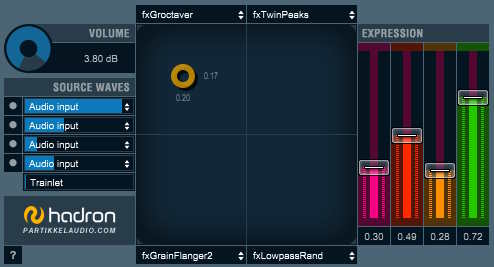Hadron Particle Synthesizer
Hadron is a complex granular synthesis device with approximately 200 synthesis parameters. The underlying synthesis engine was built with a primary focus on flexibility of sound processing. The high level of flexibility also led to high complexity in configuration and control of the device. A simplified control structure was developed to allow realtime performance with precise control over the large parameter set using just a few user interface controls. A specially designed modulation matrix is essential to link simplicity of control to the complexity of the parameter set in this instrument.

The graphical user interface for Hadron
The basic parameters of granular synthesis can be considered to be grain rate, grain pitch and grain shape, as well as the audio waveform inside each grain. Hadron allows mixing of 4 source waveforms inside each grain, with independent pitch and phase for each source. The source waveforms can be recorded sounds or live audio input. The grain rate and pitch can be varied at audio rate to allow for frequency modulation of both rate and pitch, and displacement of individual grains allows smooth transitions between synchronous and asynchronous variants of the technique. To enable separate processing of individual grains, a grain masking system is incorporated, enabling “per grain” specification of output routing, amplitude, pitch glissandi and more. A set of internal audio effects (ring modulators, filters, delays) are utilized for further processing of individual grains. The Hadron Particle Synthesizer also utilizes a set of modulators for automation of parameter values. The modulators are well known signal generators, e.g. 4 low frequency oscillators, 4 envelope generators and 4 random generators. In addition, audio analysis data (amplitude, pitch, transients) for the source waveforms are also used as modulator signals. Within Hadron, any signal that can affect a parameter value is considered a modulator, so signals from midi note input and the 4 manual expression controls (found in the graphical user interface) also counts as modulators. There is also a set of programmable modulator transform functions to allow waveshaping, division, multiplication and modulo operations on modulator signals. The full parameter set for Hadron currently counts 209 parameters and 51 modulators. The granular processing requires “only” about 40 of these parameters, and a similar amount of parameters are used for effects control. The largest chunk of parameters is actually the modulator controls (e.g. LFO amplitude, LFO frequency, Envelope attack etc.) with approximately 100 parameters.
Use cases
Hadron can be used as a synthesizer or an audio effect. It can also seamlessly morph between different sound processing methods, so you can make the plugin gradually change from synthesizer to audio processing mode. This is all part of the state morphing system, accessible via the big 2D joystick control. You can also use live sampling as a sound source for manipulation with Hadron, as well as audio files and live audio input.
Initial release with Ableton
The initial release of Hadron was made as a Max for Live device, this was done in collaboration with Ableton, as M4L was quite new at the time, and they wanted to show how its features could be utilized to produce professional grade effects. This collaboration enabled a high visibility for Hadron, and we had a quite massive amount of downloads already the first week after release. Later, we reworked the plugin into a standard VST format to enable using it with any DAW, not just with Abletone Live. The screenshot above is from the VST versionof Hadron.
Sound examples
Here are some sound examples of Hadron in action
Live processing of vocal sounds. Tone Åse - vocals
Snippet of Hadron synthesis demo piece. All sounds except drums are made with Hadron
Snippet of an electroacoustic composition made from improvisations with Hadron
Tags: dsp, selected